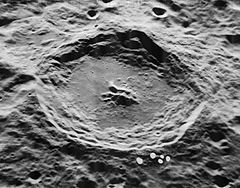Kovalevskaya (crater)
 Kovalevskaya seen by Lunar Orbiter 5 | |
| Coordinates | 30°48′N 129°36′W / 30.8°N 129.6°W / 30.8; -129.6Coordinates: 30°48′N 129°36′W / 30.8°N 129.6°W / 30.8; -129.6 |
|---|---|
| Diameter | 115 km |
| Depth | unknown |
| Colongitude | 131° at sunrise |
| Eponym | Sofia Kovalevskaya |

LRO image

Another oblique view from Lunar Orbiter 5, with the crater at the terminator
Kovalevskaya is a prominent lunar impact crater that is located on the far side of the Moon. It lies to the southwest of the larger walled plain Landau. To the south of Kovalevskaya are the craters Poynting and Fersman.
This crater overlies nearly half of the large Kovalevskaya Q along the southwest rim. The outer rim of Kovalevskaya is generally well-formed and not significantly eroded. The inner walls have formed terraces and slumped shelves in places. At the midpoint of the interior floor is a pair of central peaks that are split down the middle by a valley running north-south. Some hills run to the east of these peaks, and there are some low hills near the northwest inner wall. The remainder of the floor is relatively level and free from significant impacts.
This feature was named after the Russian mathematician Sofia Kovalevskaya (1850–1891). The asteroid 1859 Kovalevskaya is also named in her honour.[1]
Satellite craters
By convention these features are identified on lunar maps by placing the letter on the side of the crater midpoint that is closest to Kovalevskaya.
| Kovalevskaya | Latitude | Longitude | Diameter |
|---|---|---|---|
| D | 32.7° N | 124.4° W | 21 km |
| Q | 29.4° N | 131.0° W | 101 km |
References
^ Schmadel, Lutz D. (2003). Dictionary of Minor Planet Names – (1859) Kovalevskaya. Springer Berlin Heidelberg. p. 149. ISBN 978-3-540-29925-7. Retrieved 31 October 2015..mw-parser-output cite.citation{font-style:inherit}.mw-parser-output q{quotes:"""""""'""'"}.mw-parser-output code.cs1-code{color:inherit;background:inherit;border:inherit;padding:inherit}.mw-parser-output .cs1-lock-free a{background:url("//upload.wikimedia.org/wikipedia/commons/thumb/6/65/Lock-green.svg/9px-Lock-green.svg.png")no-repeat;background-position:right .1em center}.mw-parser-output .cs1-lock-limited a,.mw-parser-output .cs1-lock-registration a{background:url("//upload.wikimedia.org/wikipedia/commons/thumb/d/d6/Lock-gray-alt-2.svg/9px-Lock-gray-alt-2.svg.png")no-repeat;background-position:right .1em center}.mw-parser-output .cs1-lock-subscription a{background:url("//upload.wikimedia.org/wikipedia/commons/thumb/a/aa/Lock-red-alt-2.svg/9px-Lock-red-alt-2.svg.png")no-repeat;background-position:right .1em center}.mw-parser-output .cs1-subscription,.mw-parser-output .cs1-registration{color:#555}.mw-parser-output .cs1-subscription span,.mw-parser-output .cs1-registration span{border-bottom:1px dotted;cursor:help}.mw-parser-output .cs1-hidden-error{display:none;font-size:100%}.mw-parser-output .cs1-visible-error{font-size:100%}.mw-parser-output .cs1-subscription,.mw-parser-output .cs1-registration,.mw-parser-output .cs1-format{font-size:95%}.mw-parser-output .cs1-kern-left,.mw-parser-output .cs1-kern-wl-left{padding-left:0.2em}.mw-parser-output .cs1-kern-right,.mw-parser-output .cs1-kern-wl-right{padding-right:0.2em}
.mw-parser-output .refbegin{font-size:90%;margin-bottom:0.5em}.mw-parser-output .refbegin-hanging-indents>ul{list-style-type:none;margin-left:0}.mw-parser-output .refbegin-hanging-indents>ul>li,.mw-parser-output .refbegin-hanging-indents>dl>dd{margin-left:0;padding-left:3.2em;text-indent:-3.2em;list-style:none}.mw-parser-output .refbegin-100{font-size:100%}
Andersson, L. E.; Whitaker, E. A. (1982). NASA Catalogue of Lunar Nomenclature. NASA RP-1097.
Blue, Jennifer (July 25, 2007). "Gazetteer of Planetary Nomenclature". USGS. Retrieved 2007-08-05.
Bussey, B.; Spudis, P. (2004). The Clementine Atlas of the Moon. New York: Cambridge University Press. ISBN 978-0-521-81528-4.
Cocks, Elijah E.; Cocks, Josiah C. (1995). Who's Who on the Moon: A Biographical Dictionary of Lunar Nomenclature. Tudor Publishers. ISBN 978-0-936389-27-1.
McDowell, Jonathan (July 15, 2007). "Lunar Nomenclature". Jonathan's Space Report. Retrieved 2007-10-24.
Menzel, D. H.; Minnaert, M.; Levin, B.; Dollfus, A.; Bell, B. (1971). "Report on Lunar Nomenclature by the Working Group of Commission 17 of the IAU". Space Science Reviews. 12 (2): 136–186. Bibcode:1971SSRv...12..136M. doi:10.1007/BF00171763.
Moore, Patrick (2001). On the Moon. Sterling Publishing Co. ISBN 978-0-304-35469-6.
Price, Fred W. (1988). The Moon Observer's Handbook. Cambridge University Press. ISBN 978-0-521-33500-3.
Rükl, Antonín (1990). Atlas of the Moon. Kalmbach Books. ISBN 978-0-913135-17-4.
Webb, Rev. T. W. (1962). Celestial Objects for Common Telescopes (6th revised ed.). Dover. ISBN 978-0-486-20917-3.
Whitaker, Ewen A. (1999). Mapping and Naming the Moon. Cambridge University Press. ISBN 978-0-521-62248-6.
Wlasuk, Peter T. (2000). Observing the Moon. Springer. ISBN 978-1-85233-193-1.